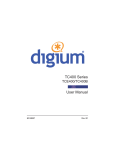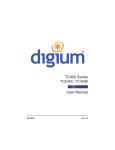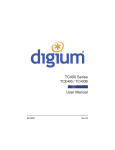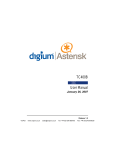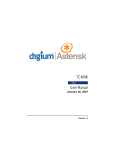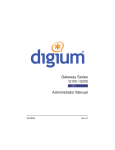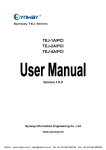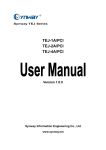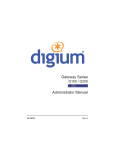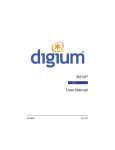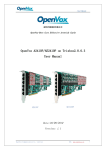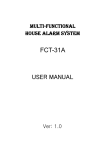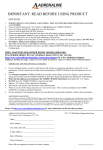Download TC400 Series User Manual
Transcript
TC400 Series TCE400/TC400B User Manual 601-00007 Rev. B Digium, Inc. 445 Jan Davis Drive NW Huntsville, AL 35806 United States Main Number: 1.256.428.6000 Tech Support: 1.256.428.6161 U.S. Toll Free: 1.877.344.4861 Sales: 1.256.428.6262 www.digium.com www.asterisk.org www.asterisknow.org © Digium, Inc. 2008 All rights reserved. No part of this publication may be copied, distributed, transmitted, transcribed, stored in a retrieval system, or translated into any human or computer language without the prior written permission of Digium, Inc. Digium, Inc. has made every effort to ensure that the instructions contained in this document are adequate and error free. The manufacturer will, if necessary, explain issues which may not be covered by this documentation. The manufacturer’s liability for any errors in the documents is limited to the correction of errors and the aforementioned advisory services. This document has been prepared for use by professional and properly trained personnel, and the customer assumes full responsibility when using it. Adobe and Acrobat are registered trademarks, and Acrobat Reader is a trademark of Adobe Systems Incorporated. Asterisk and Digium are registered trademarks and Asterisk Business Edition, AsteriskNOW, AsteriskGUI, and Asterisk Appliance are trademarks of Digium, Inc. Any other trademarks mentioned in the document are the property of their respective owners. Digium, Inc. Page 2 Safety Certification and Agency Approvals Safety: UL 60950-1:2003, First Edition CSA C22.2 No. 60950-1-03 1st Ed. April 1, 2003 IEC 60950-1:2001 First Edition EN 60950 AS/NZS 60950 Note: Finland, Norway and Sweden require that equipment using this product must be located in a Restricted Access Location (RAL). Emissions: 47 CFR Part 15, Subpart B / 47 CFR Part 15, Subpart B, Class B EN 55022:1998 Class B / EN 55022:1998 Class B Radiated and Conducted EN 55024:1998 / IEC 61000 Immunity: EN55024 ITE, EN61000 FCC Part 15: This device complies with part 15 of FCC rules. Operation is subject to the following two conditions: (1) This device may not cause harmful interference, and (2) This device must accept any interference received, including interference that may cause undesired operation. Digium, Inc. Page 3 Introduction to TC400 Series Documentation This manual contains product information for the TC400 Series cards. Be sure to refer to any supplementary documents or release notes that were shipped with your equipment. The manual is organized in the following manner: Chapter/ Appendix Title Description 1 Overview Identifies the features of your card. This chapter covers applications and uses of the TC400 Series in the real world. 2 Card Installation Provides instructions for installing the card in your PC, acquiring correct drivers, and checking device compatibility. 3 Configuration Provides examples for configuring options. 4 Questions and Answers Explains resolutions to common problems and frequently asked questions pertaining to card installation and usage. A Specifications Details card specifications. B Glossary and Acronyms Defines terms related to this product. Digium, Inc. Page 4 Symbol Definitions Caution statements indicate a condition where damage to the unit or its configuration could occur if operational procedures are not followed. To reduce the risk of damage or injury, follow all steps or procedures as instructed. The ESD symbol indicates electrostatic sensitive devices. Observe precautions for handling devices. Wear a properly grounded electrostatic discharge (ESD) wrist strap while handling the device. The Electrical Hazard Symbol indicates a possibility of electrical shock when operating this unit in certain situations. To reduce the risk of damage or injury, follow all steps or procedures as instructed. Digium, Inc. Page 5 Important Safety Instructions User Cautions Power Source. The outlet should be installed near the equipment and be easily accessible. Applying Power. Use only the power cord, power supply, and/or batteries indicated in the manual. Do not dispose of batteries in a fire. The may explode. Check with local codes for special disposal instructions. Installation This card is for use only with compatible UL Listed computers that have Installation Instructions detailing installation of card cage accessories. Servicing. Do not attempt to service this card unless specifically instructed to do so. Do not attempt to remove the card from your equipment while power is present. Refer servicing to qualified service personnel. Water and Moisture. Do not spill liquids on this unit. Do not operate this equipment in a wet environment. Heat. Do not operate or store this product near heat sources such as radiators, air ducts, areas subject to direct, intense sunlight, or other products that produce heat. Static Electricity. To reduce the risk of damaging the unit or your equipment, do not attempt to open the enclosure or gain access to areas where you are not instructed to do so. Refer servicing to qualified service personnel. Save these instructions for future reference. Digium, Inc. Page 6 TABLE OF CONTENTS Chapter 1 Overview . . . . . . . . . . . . . . . . . . . . . . . . . . . . . . . . . . . . . . . . . . . . . . . 11 What is Asterisk®? . . . . . . . . . . . . . . . . . . . . . . . . . . . . . . . . . . . . . 14 Asterisk as a Switch (PBX) . . . . . . . . . . . . . . . . . . . . . . . . . . . . . . . 14 Asterisk as a Gateway . . . . . . . . . . . . . . . . . . . . . . . . . . . . . . . . . . 14 Asterisk in the Call Center . . . . . . . . . . . . . . . . . . . . . . . . . . . . . . . 15 Asterisk in the Network . . . . . . . . . . . . . . . . . . . . . . . . . . . . . . . . . . 15 Asterisk Everywhere . . . . . . . . . . . . . . . . . . . . . . . . . . . . . . . . . . . . 15 Chapter 2 Card Installation . . . . . . . . . . . . . . . . . . . . . . . . . . . . . . . . . . . . . . . . . 16 Unpacking the Card . . . . . . . . . . . . . . . . . . . . . . . . . . . . . . . . . . . .17 Shipment Inspection . . . . . . . . . . . . . . . . . . . . . . . . . . . . . . . . . . . . 17 Slot Compatibility . . . . . . . . . . . . . . . . . . . . . . . . . . . . . . . . . . . . . . 20 Hardware Installation . . . . . . . . . . . . . . . . . . . . . . . . . . . . . . . . . . . 22 Software Installation . . . . . . . . . . . . . . . . . . . . . . . . . . . . . . . . . . . .23 Installing DAHDI . . . . . . . . . . . . . . . . . . . . . . . . . . . . . . . . . . . . . . .25 Installing Asterisk . . . . . . . . . . . . . . . . . . . . . . . . . . . . . . . . . . . . . . 27 Chapter 3 Configuration . . . . . . . . . . . . . . . . . . . . . . . . . . . . . . . . . . . . . . . . . . . . 29 Chapter 4 Questions and Answers . . . . . . . . . . . . . . . . . . . . . . . . . . . . . . . . . . . 30 Digium, Inc. Page 7 Table Of Contents Appendix A Specifications . . . . . . . . . . . . . . . . . . . . . . . . . . . . . . . . . . . . . . . . . . . 32 Appendix B Glossary and Acronyms . . . . . . . . . . . . . . . . . . . . . . . . . . . . . . . . . . . 34 Digium, Inc. Page 8 List of Figures Figure 1: Figure 2: Figure 3: Figure 4: Figure 5: Figure 6: Digium, Inc. Sample Telco Application . . . . . . . . . . . . . . . . . . . . . 12 Sample Network Application . . . . . . . . . . . . . . . . . . . 13 TC400B Card . . . . . . . . . . . . . . . . . . . . . . . . . . . . . . 18 TCE400 Card . . . . . . . . . . . . . . . . . . . . . . . . . . . . . . 19 Motherboard Slots . . . . . . . . . . . . . . . . . . . . . . . . . . 20 Insert the Card . . . . . . . . . . . . . . . . . . . . . . . . . . . . .22 Page 9 List of Tables Table A-1: Digium, Inc. Maximum Power Consumption . . . . . . . . . . . . . . . . .33 Page 10 Chapter 1 Overview The TC400 Series cards are a bundle of the half-length, low-profile TC400P (PCI) or TCE400 (PCI-E) base card and the TC400M voice processing module. The TC400 Series cards are designed to handle, in dedicated DSP resources, the complex codec translations for highly compressed audio as would otherwise be processed by Asterisk in software. Asterisk, in software and with Digium® G.729a licensing, is capable of transforming the G.729a codec into other codecs for the purposes of call origination or termination, bridging disparate calls, or VoIP to TDM connectivity. These transformations in software are very expensive, in terms of MIPS, and require a substantial amount of CPU time to accomplish. A TC400 Series card not only relieves the CPU of this duty, freeing it up to handle other tasks or to complete additional call processing; but also provides Asterisk with the capability of bridging G.723.1 compressed audio into other formats, a capability not previously possible. The TC400 Series cards decompress G.729a (8.0 Kbit) or G.723.1 (5.3 Kbit and 6.3 Kbit) into u-law or a-law; or, compress u-law or a-law into G.729a (8.0 Kbit) or G.723.1 (5.3 Kbit and 6.3 Kbit). The TC400 Series cards are rated to handle up to 120 bi-directional G.729a transformations or 92 bi-directional G.723.1 transformations. The TC400 Series cards do not require additional licensing fees for the use of these codecs nor do Digium, Inc. Page 11 Chapter 1: Overview they require the registration process associated with Digium's softwarebased G.729a codec licensing. Features: 120 channels of bi-directional G.729a (8 Kbit) transcoding or 92 channels of bi-directional G.723.1 (5.3 Kbit and 6.3 Kbit) transcoding Figure 1: Sample Telco Application Digium, Inc. Page 12 Chapter 1: Overview Figure 2: Sample Network Application Digium, Inc. Page 13 Chapter 1: Overview What is Asterisk®? Asterisk is the world’s leading open source telephony engine and tool kit. Offering flexibility unheard of in the world of proprietary communications, Asterisk empowers developers and integrators to create advanced communication solutions...for free. Asterisk is released as open source under the GNU General Public License (GPL), and it is available for download free of charge. Asterisk is the most popular open source software available, with the Asterisk Community being the top influencer in VoIP. Asterisk as a Switch (PBX) Asterisk can be configured as the core of an IP or hybrid PBX, switching calls, managing routes, enabling features, and connecting callers with the outside world over IP, analog (POTS), and digital (T1/E1) connections. Asterisk runs on a wide variety of operating systems including Linux, Mac OS X, OpenBSD, FreeBSD, and Sun Solaris. It provides all of the features you would expect from a PBX including many advanced features that are often associated with high end (and high cost) proprietary PBXs. Asterisk's architecture is designed for maximum flexibility and supports Voice over IP in many protocols, and can interoperate with almost all standards-based telephony equipment using relatively inexpensive hardware. Asterisk as a Gateway It can also be built out as the heart of a media gateway, bridging the legacy PSTN to the expanding world of IP telephony. Asterisk’s modular architecture allows it to convert between a wide range of communications protocols and media codecs. Digium, Inc. Page 14 Chapter 1: Overview Asterisk as a Feature/Media Server Need an IVR? Asterisk’s got you covered. How about a conference bridge? Yep. It’s in there. What about an automated attendant? Asterisk does that too. How about a replacement for your aging legacy voicemail system? Can do. Unified messaging? No problem. Need a telephony interface for your web site? Ok. Asterisk in the Call Center Asterisk has been adopted by call centers around the world based on its flexibility. Call center and contact center developers have built complete ACD systems based on Asterisk. Asterisk has also added new life to existing call center solutions by adding remote IP agent capabilities, advanced skills-based routing, predictive and bulk dialing, and more. Asterisk in the Network Internet Telephony Service Providers (ITSPs), competitive local exchange carriers (CLECS) and even first-tier incumbents have discovered the power of open source communications with Asterisk. Feature servers, hosted services clusters, voicemail systems, pre-paid calling solutions, all based on Asterisk have helped reduce costs and enabled flexibility. Asterisk Everywhere Asterisk has become the basis for thousands of communications solutions. If you need to communicate, Asterisk is your answer. For more information on Asterisk visit http://www.asterisk.org or http:// www.digium.com. Digium, Inc. Page 15 Chapter 2 Card Installation This chapter provides the following information: Unpacking the Card on page 17 Shipment Inspection on page 17 Slot Compatibility on page 20 Hardware Installation on page 22 Software Installation on page 23 Note: The TC400 Series card installation instructions are written so that they will apply to any card in the series. Examples and card specific information are included as needed. Digium, Inc. Page 16 Chapter 2: Card Installation Unpacking the Card When you unpack your card, carefully inspect it for any damage that may have occurred in shipment. If damage is suspected, file a claim with the carrier and contact your reseller from which the card was purchased, or Digium Technical Support (+1.256.428.6161). Keep the original shipping container to use for future shipment or proof of damage during shipment. Note: Only qualified service personnel should install the card. Users should not attempt to perform this function. Shipment Inspection The following items are included in the shipment of the TC400 Series card: A TC400B or TCE400 card TC400M voice processing module (installed on TC400B or TC400 card) Caution. Only qualified service personnel should continue with hardware installation and configuration of the TC400 Series card. Users should not attempt to perform these functions. This card is for use in Listed I.T.E. (information technology equipment) only. Digium, Inc. Page 17 Chapter 2: Card Installation TC400M voice processing module Keyed for 3.3 or 5 volt PCI Figure 3: TC400B Card Digium, Inc. Page 18 Chapter 2: Card Installation Figure 4: TCE400 Card Digium, Inc. Page 19 Chapter 2: Card Installation Slot Compatibility Check the type of card you received to be sure it is compatible with your PCI slot. To determine which slot you have, identify it by comparing it to those shown in the figure below. Slot Number: 0: AGP Pro Slot 1: 64-bit 5.0 volt PCI Slot 2: 64-bit 3.3 volt PCI Slot 3: 32-bit 5.0 volt PCI Slot 4: PCI Express Slot Slots 0 1 2 3 4 Figure 5: Motherboard Slots Digium, Inc. Page 20 Chapter 2: Card Installation The TC400B is a 32-bit 33MHz card keyed for universal 3.3 volt or 5.0 volt operation and works in any PCI 2.2 (or greater) compliant slot. This means that in the motherboard shown in Figure 5, the TC400B card will fit into Slots 1, 2, or 3 (PCI slots) but will not fit into Slot 0 (AGP slot). The TCE400 card is a PCI Express card. Slot 4, illustrated above, is a 1 lane (X1) PCI Express compliant slot. The TCE400 will work in any PCI Express compliant slot, including lane lengths X1, X4, X8, and X16. This means that in the motherboard shown in Figure 5, the TCE400 will only fit into Slot 4. The TCE400 can not be used in Slots 0 through 3. Digium, Inc. Page 21 Chapter 2: Card Installation Hardware Installation 1. Power down your computer and unplug it from its power source. 2. Attach a static strap to your wrist and open the case. 3. Remove the bracket place holder and insert the card into the PCI or PCI Express slot. See Figure 6. Figure 6: Insert the Card 4. Replace the cover to your computer. Digium, Inc. Page 22 Chapter 2: Card Installation Software Installation Digium hardware requires drivers and libraries that are not integrated with the Linux kernel. Digium hardware is only supported under Linux. Digium recommends CentOS, Debian, Red Hat, and Ubuntu distributions of Linux. However, many other distributions are supported by Digium Technical Support. Digium’s software, including drivers and application software, may be obtained from Digium’s download server at: http://downloads.digium.com For an introduction to Asterisk, Digium’s telephony software, including additional information on its configuration, setup, and features, please refer to: http://www.asterisk.org For the latest information on setting up and configuring DAHDI drivers for your Digium hardware product, please refer to the latest release of this manual which is available from the product-specific documentation section at: http://www.digium.com To install your TC400 Series card, you will need: Linux 2.6 kernel headers Development libraries and headers for ncurses Development libraries and headers for zlib and openssl Development libraries and headers for newt GCC and standard software build tools Digium, Inc. Page 23 Chapter 2: Card Installation It is recommended that you use the most recent version of the Asterisk and DAHDI software for the best results. If you have previously installed either of these, Digium recommends that you upgrade to the latest “current” version of each. Note: If you are using the 1.4.x series of Asterisk, you will need Asterisk 1.4.22 or newer. Digium, Inc. Page 24 Chapter 2: Card Installation Installing DAHDI 1. Download the latest DAHDI drivers with tools. DAHDI is available for download from: http://downloads.digium.com/pub/telephony/dahdi-linux-complete # wget http://downloads.digium.com/pub/telephony/ dahdi-linux-complete/dahdi-linux-complete-current. tar.gz 2. Expand the downloaded file, compile its contents, and install the drivers and tools. Substitute the version of DAHDI for the X.X.X in the command lines below. # # # # tar -zxvf dahdi-linux-complete-current.tar.gz cd dahdi-linux-complete-X.X.X+X.X.X make make install 3. Load DAHDI drivers into the kernel using the modprobe utility. The appropriate driver for a TC400 Series card is wctc4xxp. # modprobe wctc4xxp Digium, Inc. Page 25 Chapter 2: Card Installation 4. Confirm that the card was started successfully by running the dmesg command. # dmesg The end of the output should look similar to the following: dahdi_transcode: Loaded. wctc4xxp: tc400b0: Attached to device at 0000:00:0a.0. wctc4xxp: tc400b0: (G.729a / G.723.1) Transcoder support LOADED (firm ver = 6.12) wctc4xxp: tc400b0: Installed a Wildcard TC: Wildcard TC400P+TC400M dahdi_transcode: Registered codec translator 'DTE Encoder' with 92 transcoders (srcs=0000000c, dsts=00000101) dahdi_transcode: Registered codec translator 'DTE Decoder' with 92 transcoders (srcs=00000101, dsts=0000000c) Digium, Inc. Page 26 Chapter 2: Card Installation Installing Asterisk If you wish to use Asterisk with your new hardware, you can follow the instructions below. 1. Download the latest release version of Asterisk, either 1.4.22 (or later) or 1.6.0.1 (or later). Substitute the version of Asterisk for the X.X in the command below. Asterisk is available for download from: http://downloads.digium.com/pub/telephony/asterisk # wget http://downloads.digium.com/pub/telephony/ asterisk/asterisk-X.X-current.tar.gz 2. Expand the downloaded file, compile its contents, and install the application. Substitute the version of Asterisk for the X.X and X.X.X in the command lines below. # # # # # # tar -zxvf asterisk-X.X-current.tar.gz cd asterisk-X.X.X/ ./configure make menuselect make make install Digium, Inc. Page 27 Chapter 2: Card Installation 3. If this is the first Asterisk installation on this system, you should install the sample configuration files. To do this, run: # make samples Note: Running this command will overwrite, after making a backup copy, any older Asterisk configuration files that you have in the /etc/ asterisk directory. If your installation has failed, it may be because you are missing one or more of the build dependencies, the kernel headers, or the development tools. Please contact your reseller where the card was purchased, or call Digium Technical Support (+1.256.428.6161) for assistance. Note: Complete instructions for installing Asterisk are available at www.asterisk.org. Digium, Inc. Page 28 Chapter 3 Configuration No changes to system.conf or chan_dahdi.conf are necessary to utilize this card. The ‘mode’ module parameter may be used to specify whether the card can be used to transcode G.729a, G.723.1, or both. mode = mixed: This default option will enable 92 calls of G.729a or G.723.1 (5.3 Kbit and 6.3 Kbit) mode = g729: This option will enable 120 calls of G.729a mode = g723: This option will enable 92 calls of G.723.1 (5.3 Kbit and 6.3 Kbit) Testing Your Configuration: 1. Start Asterisk by typing: # asterisk -vvvvc 2. Verify that the TC400 Series is registered with Asterisk by issuing the following command on the Asterisk CLI. *CLI> show transcoder This should display the number of encoders and decoders registered by the TC400 Series card. Digium, Inc. Page 29 Chapter 4 Questions and Answers This chapter provides frequently asked questions as identified from Digium Technical Support and possible resolutions. Multiple resources are available to obtain more information about Asterisk and Digium products. These resources are listed on page 31. Q: My card can’t seem to reach its full channel count, why? A: See next answer. Q: Asterisk issues errors such as "rtp.c: Unable to allocate socket: Too many open files." How can I prevent this? A: Each call that uses a TC400 Series card for transcoding requires two file handles. Increase the maximum number of open file descriptors allowed on your system using the ulimit utility. First, log into a Linux shell as the user running the asterisk process (i.e. usually root). Check the current maximum by executing ulimit -n. Increase the maximum by executing ulimit -n [limit] (e.g. ulimit -n 32768). Q: Does my card take 1000 interrupts per second like my other Digium cards? A: A TC400 Series card only takes interrupts when it is in an active transcoding state, and will not pull interrupts when it is idling. This is different behavior than Digium analog and digital interface cards exhibit. Q: Does my TC400 Series card serve as a DAHDI timing device? A: No, a TC400 Series card cannot serve as a DAHDI timing device. If you have no other Digium cards installed which can serve as a DAHDI Digium, Inc. Page 30 Chapter 4: Questions and Answers timing device, you can use the dahdi_dummy kernel module to serve as one. The dahdi_dummy kernel module can be loaded by executing modprobe dahdi_dummy. Where can I ask even more questions? There are several places to inquire for more information about Digium products: 1. Digium Technical Support (+1.256.428.6161) is available 7am-8pm Central Time, Monday - Friday. 2. Asterisk forums (forums.digium.com). 3. Asterisk users mailing list (lists.digium.com). 4. IRC channel #asterisk on (irc.freenode.net). Digium, Inc. Page 31 Appendix A Specifications This appendix provides specifications, required environmental conditions, and maximum power consumption for the TC400 Series cards. Physical. Size: Weight: 4.69” × 2.52” × 0.63” (11.9 x 6.4 x 1.6 cm) PCB size, does not include the PCI bracket 2.5 oz (70.9 gm) Interfaces. PCI Bus (TC400B): 3.3V or 5V bus slot, half-length slot minimum size, 33MHz minimum bus speed, compliant with PCI 2.2 or greater. PCI-E Bus (TCE400) - Compliant with PCI-E X1 1.0 or greater. Environment. Temperature: 0 to 50° C (32 to 122° F) operation -20 to 65° C (4 to 149° F) storage Humidity: 10 to 90% non-condensing Digium, Inc. Page 32 Appendix A: Specifications Supported Codecs. G.729a (8.0 Kbit) G.723.1 (5.3 Kbit and 6.3 Kbit) μ-law (u-law) α-law (a-law) Hardware and Software Requirements. 400 Mhz Pentium III or better 512 MB RAM Available PCI or PCI-E Slot (as described previously) Linux 2.6 kernel Table A-1: Maximum Power Consumption Model Digium, Inc. Power TC400B 3.3V 5V 12V 0 Watts 4 Watts 0 Watts TCE400 3.3V 5V 12V 0 Watts 4 Watts 5 Watts Page 33 Appendix B Glossary and Acronyms a-law Mainly used in European telephone networks for the conversion between analog and digital signals in PCM applications. Similar to the North American mu-law standard. Refer to G.711 on page 38 and mu-law on page 43. ANSI American National Standards Institute An organization which proposes and establishes standards for international communications. asynchronous Not synchronized; not timed to an outside clock source. Transmission is controlled by start bits at the beginning and stop bits at the end of each character. Asynchronous communications are often found in internet access and remote office applications. attenuation The dissipation of a transmitted signal’s power as it travels over a wire. bandwidth The capacity to carry traffic. Higher bandwidth indicates the ability to transfer more data in a given time period. Digium, Inc. Page 34 Appendix B: Glossary and Acronyms bit The smallest element of information in a digital system. A bit can be either a zero or a one. bps bits per second A measurement of transmission speed across a data connection. broadband Broadband transmission shares the bandwidth of a particular medium (copper or fiber optic) to integrate multiple signals. The channels take up different frequencies on the cable, integrating voice, data, and video over one line. channel A generic term for an individual data stream. Service providers can use multiplexing techniques to transmit multiple channels over a common medium. Cat5 Category of Performance for wiring and cabling. Cat 5 cabling support applications up to 100 MHz. Cat5E Category of Performance for wiring and cabling. Category 5 Enhanced wiring supports signal rates up to 100 MHz but adheres to stricter quality specifications. Digium, Inc. Page 35 Appendix B: Glossary and Acronyms CLEC competitive local exchange carrier A term for telephone companies established after the Telecommunications Act of 1996 deregulated the LECs. CLECs compete with ILECs to offer local service. See also LEC and ILEC. CO central office The CO houses local switching equipment. All local access lines in a particular geographic area terminate at this facility (which is usually owned and operated by an ILEC). CPE customer premises equipment Terminal equipment which is connected to the telecommunications network and which resides within the home or office of the customer. This includes telephones, modems, terminals, routers, and television set-top boxes. DAHDI Digium Asterisk Hardware Device Interface A telephony project dedicated to implementing a reasonable and affordable computer telephony platform into the world marketplace. Also, the collective name for the Digium-provided drivers for Digium telephony interface products. DS0 Digital Signal, Level 0 A voice grade channel of 64 Kbps. The worldwide standard speed for digitizing voice conversation using PCM (Pulse Code Modulation). Digium, Inc. Page 36 Appendix B: Glossary and Acronyms DS1 Digital Signal, Level 1 1.544 Mbps in North America (T1) and Japan (J1) -up to 24 voice channels (DS0s), 2.048 Mbps in Europe (E1) - up to 32 voice channels (DS0s). DS1/T1/E1 lines are part of the PSTN. DS3 Digital Signal, Level 3 T3 in North America and Japan, E3 in Europe. Up to 672 voice channels (DS0s). DS3/T3/E3 lines are not part of the PSTN DTMF Dual Tone Multi-Frequency Push-button or touch tone dialing. E1 The European equivalent of North American T1, transmits data at 2.048 Mbps, up to 32 voice channels (DS0s). E3 The European equivalent of North American T3, transmits data at 34.368 Mbps, up to 512 voice channels (DS0s). Equivalent to 16 E1 lines. EMI Electromagnetic Interference Unwanted electrical noise present on a power line full duplex Data transmission in two directions simultaneously. Digium, Inc. Page 37 Appendix B: Glossary and Acronyms FXO Foreign Exchange Office Receives the ringing voltage from an FXS device. Outside lines are connected to the FXO port on your TC400 Series card. FXS Foreign Exchange Station Initiates and sends ringing voltage. Phones are connected to the FXS ports on the TC400 Series card. G.711 A recommendation by the Telecommunication Standardization Sector (ITU-T) for an algorithm designed to transmit and receive mulaw PCM voice and A-law at a digital bit rate of 64 Kbps. This algorithm is used for digital telephone sets on digital PBX. G.723.1 A recommendation by the Telecommunication Standardization Sector (ITU-T) for an algorithm designed to transmit and receive audio over telephone lines at 6.3 Kbps or 5.3 Kbps. G.729a A recommendation by the Telecommunication Standardization Sector (ITU-T) for an algorithm designed to transmit and receive audio over telephone lines at 8 Kbps. H.323 A recommendation by the Telecommunication Standardization Sector (ITU-T) for multimedia communications over packet-based networks. Digium, Inc. Page 38 Appendix B: Glossary and Acronyms IAX Inter-Asterisk eXchange A VoIP protocol used by Asterisk. It is used to enable VoIP connections between Asterisk servers, and between servers and clients that also use the IAX protocol. iLBC internet Low Bitrate Codec A free speech codec used for voice over IP. It is designed for narrow band speech with a payload bitrate of 13.33 kbps (frame length = 30ms) and 15.2 kbps (frame length = 20 ms). ILEC incumbent local exchange carrier The LECs that were the original carriers in the market prior to the entry of competition and therefore have the dominant position in the market. interface A point of contact between two systems, networks, or devices. ISO International Standards Organization LED light-emitting diode Linux A robust, feature-packed open source operating system based on Unix that remains freely available on the internet. It boasts dependability and offers a wide range of compatibility with hardware and software. Asterisk is supported exclusively on Linux. Digium, Inc. Page 39 Appendix B: Glossary and Acronyms loopback A state in which the transmit signal is reversed back as the receive signal, typically by a far end network element. MGCP Media Gateway Control Protocol multiplexing Transmitting multiple signals over a single line or channel. FDM (frequency division multiplexing) and TDM (time division multiplexing) are the two most common methods. FDM separates signals by dividing the data onto different carrier frequencies, and TDM separates signals by interleaving bits one after the other. MUX multiplexer A device which transmits multiple signals over a single communications line or channel. See multiplexing. PBX private branch exchange A smaller version of a phone company’s large central switching office. Example: Asterisk. PCI peripheral component interconnect A standard bus used in most computers to connect peripheral devices. POP point of presence The physical connection point between a network and a telephone network. A POP is usually a network node serving as the equivalent of a CO to a network service provider or an interexchange carrier. Digium, Inc. Page 40 Appendix B: Glossary and Acronyms POTS plain old telephone service Standard phone service over the public switched telephone network (PSTN). This service provides analog bandwidth of less than 4 kHz. PPP point-to-point protocol Type of communications link that connects a single device to another single device, such as a remote terminal to a host computer. PSTN public switched telephone network A communications network which uses telephones to establish connections between two points. Also referred to as the dial network. QoS quality of service A measure of telephone service, as specified by the Public Service Commission. RJ11 A six-pin jack typically used for connecting telephones, modems, and fax machines in residential and business settings to PBX or the local telephone CO. SIP Session Initiation Protocol An IETF standard for setting up sessions between one or more clients. It is currently the leading signaling protocol for Voice over IP, gradually replacing H.323. Digium, Inc. Page 41 Appendix B: Glossary and Acronyms T1 A dedicated digital carrier facility which transmits up to 24 voice channels (DS0s) and transmits data at 1.544 Mbps. Commonly used to carry traffic to and from private business networks and ISPs. T3 A dedicated digital carrier facility which consists of 28 T1 lines and transmits data at 44.736 Mbps. Equivalent to 672 voice channels (DS0s). TDM time division multiplexer A device that supports simultaneous transmission of multiple data streams into a single high-speed data stream. TDM separates signals by interleaving bits one after the other. telco A generic name which refers to the telephone companies throughout the world, including RBOCs, LECs, and PTTs. tip and ring The standard termination on the two conductors of a telephone circuit; named after the physical appearance of the contact areas on the jack plug. twisted pair Two copper wires commonly used for telephony and data communications. The wires are wrapped loosely around each other to minimize radio frequency interference or interference from other pairs in the same bundle. Digium, Inc. Page 42 Appendix B: Glossary and Acronyms u-law Also known as mu law, is the PCM quasi-logarithmic curve. It is the 64 Kbps standard North America voice amplitude sample used for encoding/decoding. V volts VoIP Voice over IP Technology used for transmitting voice traffic over a data network using the Internet Protocol. Digium, Inc. Page 43











































